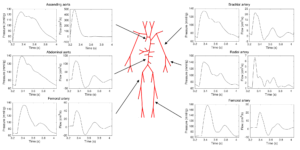Pulse wave propagation modeling

Intermittent hemodialysis (HD) is the main method of renal replacement therapy in patients with end stage renal disease. Cardiovascular complications related to atherosclerosis and vascular calcification are the most frequent cause of death in this group of patients. A relatively new non-invasive tool for the assessment of the status of arteries is applanation tonometry that allows for precise measurements of the pulse wave shape and its velocity in peripheral (e. g. radial) arteries. Importantly, by performing pulse-wave analysis on a peripheral artery, one can estimate the central aortic pulse shape that is crucial for the stratification of CV disease risk. The required permanent blood access, such as arteriovenous fistula, induces substantial changes in systemic and peripheral blood circulation and has substantial impact on the measured pulse wave. There are also other important factors that have to be taken into account, such as the changes in fluid overload and blood volume during hemodialysis session and the changes in vascular resistance due to modifications of vasodilatation of the capillary bed. These factors make the standard interpretation of pulse wave analysis problematic if applied to patients on hemodialysis and there is a need for a theoretical evaluation that can combine all important factors. On the other hand, applanation tonometry may help to better understand and assess the status of the arteriovenous fistula and other possible clinical complications that occur in HD patients. We hypothesize that the presence of the fistula and other abnormalities in vascular system of HD patients may influence the standard assumptions necessary for pulse wave analysis and its interpretation.
Our main objective is to investigate the role of various abnormalities in HD patients on the propagation of pulse wave using mathematical modeling of the whole arterial tree with arteriovenous fistula and compare these predictions to the respective clinical measurements.
We propose the application of a mathematical model of pulse wave propagation in the whole arterial system modified and extended by the arteriovenous fistula for the analysis of the role of various possible (patho-)physiological conditions that may have an impact on the measured pulse wave. The models of pulse wave propagation describe 1D flow in compliant arterial vessels using two variables: blood flow velocity and blood pressure (or equivalently the cross-sectional area of compliant vessel), and were previously shown to be in agreement with rich set of physiological data. The mathematical modeling will be applied for the analysis of the results of a new clinical study that involves non-invasive measurements of pulse wave at different places of arteriovenous system before, during and after hemodialysis session together with non-invasive assessment of the heart activity (by impedance cardiography) and the changes in fluid status of the patient (intracellular and extracellular water by bioimpedance, blood volume by online measurement of changes in hematocrit) that strongly influence the pulse wave propagation.
